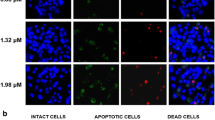Abstract
Objective
To investigate the death mode of human hepatoma cells exposed to matrine and the role of glutathione (GSH) and cytochrome c.
Methods
The MTT test and Cell Death Detection ELISA were used to identify cell death mode and viability of cells exposed to matrine. The volume of intracellular GSH was detected by GSH reductase. Finally Western blotting was chosen to analyze the expression of cytochrome c and Caspase-9 in HepG2 cells treated by matrine.
Results
The apoptotic cell death induced by matrine in Hep G2 cells dramatically increased in the time-, dose-dependent manner. Matrine can exhaust intracellular GSH effectively to change the redox state in cells. Furthermore it affect the cytotoxicity of matrine. Results of Western blotting showed that matrine induced the release of cytochrome c from mitochondria to cytoplasm, and then stimulate the cleavage of Caspase-9 in a time-dependent manner.
Conclusion
Matrine induced apoptosis in Hep G2 cells through the mitochondrial pathway, and oxidative stress via depletion of GSH is directly involved in the apoptotic process.
Similar content being viewed by others
References
Lin W, Zhang JP, Hu ZL, et al. Inhibitory effect of matrine on lipopolys acchride-induced tumor necros is factor and interleukin-6 production from rat Kupffer cells. Acta Pharm Sin, 1997, 32: 93–96.
Liang P, Bo AH, Xue GP. Study on the mechanism of matrine on immune liver injury in rats. World Chin J Digest (Chinese), 1999, 7: 104–108.
Zhang JP, Zhang M, Zhou JP, et al. Antifibrotic effects of matrine on in vitro and in vivo models of liver fibrosis in rats. Acta Pharmacol Sin, 2001, 22: 183–186.
Ai J, Gao HH, He SZ, et al. Effects of matrine, artemisinin, and tetrandrine on cytosolic [Ca2+] in guinea pig ventricular myocytes. Acta Pharmacol Sin, 2001, 22: 512–515.
Tao SC, Wang JZ. The pharmacological function of matrine. Acta Pharmacol Sin, 1992, 27: 201.
Zhang Y, Jiang JK, Liu XS, et al. Cloning of differentiation-related cDNA induced by matrine from K562 cell line. Chin J Cancer (Chinese), 2000, 19: 756–758.
Deneke SM, Fanburg BL. Regulation of cellular glutathione. Am J Physiol, 1989, 257: L163–L173.
Coffey RN, Watson RW, Hegarty NJ, et al. Thiol-mediated apoptosis in prostrate carcinoma cells. Cancer, 2000, 88: 2092–2104.
Macho A, Hirsch T, Marzo I, et al. Glutathione depletion is an early and calcium elevation is a late event of thymocyte apoptosis. J Immunol, 1997, 158: 4612–4619.
Anderson CP, Tsai JM, Meek WE, et al. Depletion of glutathione by buthionine sulfoxine is cytotoxic for human neuroblastoma cells lines via apoptosis. Exp Cell Res, 1999, 246: 183–192.
Li P, Nijhawan D, Budihardjo I, et al. Cytochrome c and dATP-dependent formation of Apaf-1/caspase-9 complex initiates an apoptotic protease cascade. Cell, 1997, 91: 479–489.
Slee EA, Adrain C Martin SJ. Serial killers: ordering caspase activation events in apoptosis. Cell Death Differ, 1999, 6: 1067–1074.
Degli EM, Ferry G, Masdehors P, et al. Post-translational modification of Bid has differential effects on its susceptibility to cleavage by caspase 8 or caspase 3. J Biol Chem, 2003, 278: 15749–15757.
Milosevic J, Hoffarth S, Huber C, et al. The DNA damage-induced decrease of Bcl-2 is secondary to the activation of apoptotic effector caspases. Oncogene, 2003, 22: 6852–6856.
Author information
Authors and Affiliations
Corresponding author
Additional information
Supported by a grant from the Chinese Traditional Medicine Foundation of Zhejiang (No. 2007CB184).
Rights and permissions
About this article
Cite this article
Cheng, X., Du, Y., Huang, L. et al. Effect of matrine on HepG2 cells: role of glutathione and cytochrome c. Chin. -Ger. J. Clin. Oncol. 7, 213–216 (2008). https://doi.org/10.1007/s10330-007-0190-5
Received:
Revised:
Accepted:
Published:
Issue Date:
DOI: https://doi.org/10.1007/s10330-007-0190-5




